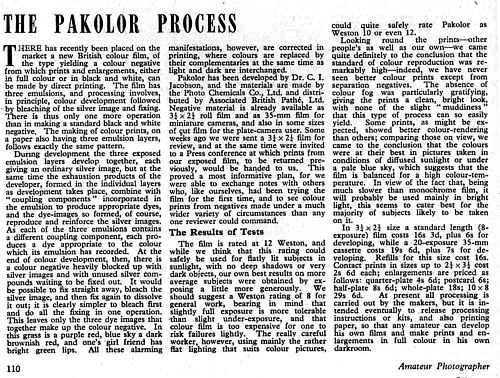| Pakolor - Amateur Photographer Test Report, 1952 |
|
|
|
|
|
It reads: The Pakolor Process THERE has recently been placed on the market a new British colour film, of the type yielding a colour negative from which prints and enlargements, either in full colour or in black and white, can be made by direct printing. The film has three emulsions and processing involves, in principle, colour development followed by bleaching of the silver image and fixing. There is thus only one more operation in making a standard black and white negative. The making of colour prints, on a paper also having three emulsion layers, follows exactly the same pattern. During development the three exposed emulsion layers develop together, each giving an ordinary silver image, but at the same time the exhaustion products of the developer, formed in the individual layers as development takes place, combine with "coupling components" incorporated in the emulsion to produce appropriate dyes, and the dye-images so formed, of course, reproduce and reinforce the silver images. |
|
|
As each of the three emulsions contains a different coupling component, each produces a dye appropriate to the colour which its emulsion has recorded. At the end of colour development, then, there is a colour negative heavily blocked up with silver images and with unused silver compounds waiting to be fixed out. It would be possible to fix straight away, bleach the silver image, and then fix again to dissolve it out; it is clearly simpler to bleach first and do all the fixing in one operation. This leaves only the three dye images that together make up the colour negative. In this, grass is a purple red, blue sky a dark brownish red, and one's girl friend has bright green lips. All these alarming manifestations, however, are corrected in printing, where colours are replaced by their complementariness at the same time as light and dark are interchanged. Pakolor has been developed by Dr. C. I. Jacobson (sic), and the materials are made by the Photo Chemical Co., Ltd. and distributed by Associated British Pathé, Ltd. Negative material is already available as 3¼ x 2¼ roll film and as 35-mm film for miniature cameras, and also in some sizes of cut film for the plate-camera user. Some weeks ago we were sent a 3¼ x 2¼ film for review, and at the same time were invited to a Press conference at which prints from our exposed film, to be returned previously, would be handed to us. This proved a most informative plan, for we were able to exchange notes with others who, like ourselves, had been trying the film for the first time, and to see colour prints from negatives made under a much wider variety of circumstances than any one reviewer could command. The Result of Tests: Looking round the prints - other people's as well as our own - we came quite definitely to the conclusion that the standard of colour reproduction was remarkably high - indeed, we have never seen better colour prints except from separation negatives. The absence of colour fog was particularly gratifying, giving the prints a clean, bright look, with none of the slight "muddiness" that this type of process can so easily yield. Some prints, as might be expected, showed better colour-rendering than others; comparing those on view, we came to the conclusion that the colours were at their best in pictures taken in conditions of diffused sunlight or under a pale blue sky, which suggests that the film is balanced for a high colour-temperature. In view of the fact that, being much slower than monochrome film, it will probably be used mainly in bright light, this seems to cater best for the majority of subjects likely to be taken on it. In 3¼ x 2¼ size a standard length (8-exposure) film costs 16s 3d, plus 6s for developing, while a 20-exposure 35-mm cassette costs 19s 6d, plus 7s for developing. Refills for this size cost 16s. Contact prints in sizes up to 3¼" x 2¼" cost 2s 6d each; enlargements are priced as follows: quarter-plate 4s 6d; postcard 6s; half-plate 8s 6d; whole-plate 18s; 10" x 8" 29s 6d. At present all processing is carried out by the makers, but it is intended eventually to release processing instructions or kits and also printing paper, so that any amateur can develop his own films and make prints and enlargements in full colour in his own darkroom. |
|
|
|
|
|
|
||
 The
Amateur Photographer test report alongside appears on page 110
of the July 23rd 1952 issue.
The
Amateur Photographer test report alongside appears on page 110
of the July 23rd 1952 issue.